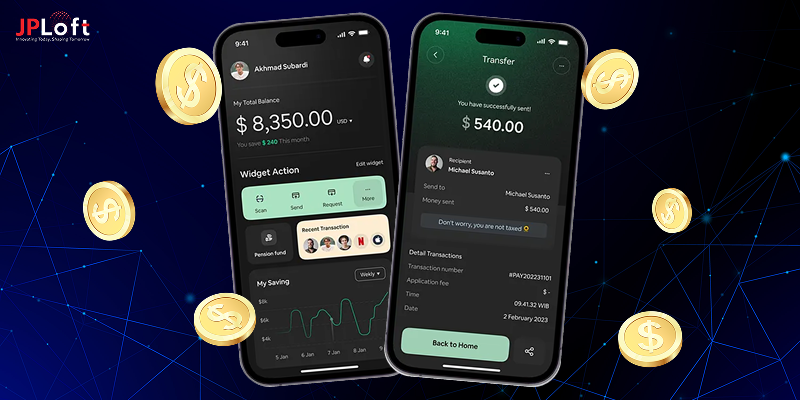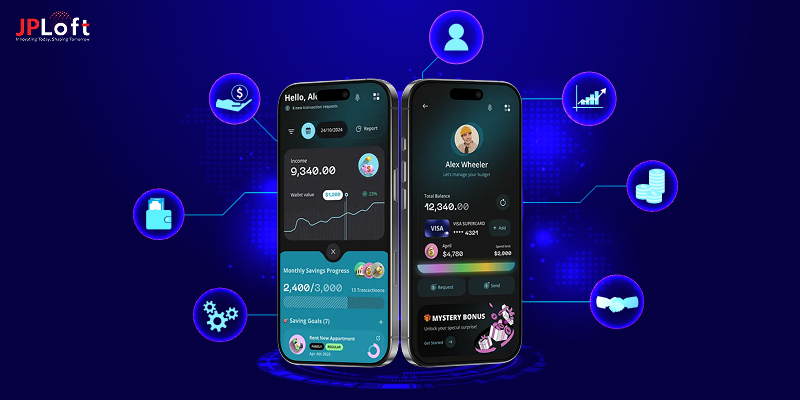Key Takeaways:
Fintech is set to cross $1.5 trillion by 2030, but such growth comes with serious development and compliance challenges.
Most fintech startups fail due to common fintech app development challenges, including weak security or missed regulations, making careful planning essential.
Following strict compliance rules like KYC, AML, and GDPR keeps apps safe from penalties and builds user confidence.
Balancing strong security with a smooth user experience creates trust while keeping fintech apps easy to use.
Emerging tech like blockchain, DeFi, and AI improves transparency, cuts costs, and delivers smarter, personalized services.
Post-launch support, updates, and monitoring are just as important as the development phase itself.
Partnering with experts like JPLoft helps overcome and build a secure, scalable, and future-ready fintech solution.
Fintech is one of the booming sectors globally, promising better growth and investment opportunities to investors. As per a report by BCG, the sector is projected to cross $1.5 trillion by 2030.
Sounds Interesting? It is, and with an innovative fintech app idea, you can also be a part of such a transforming economy and industry sector.
As an entrepreneur, you can look for potential opportunities in the fintech space and proceed with an appropriate solution that aligns with the user’s expectations and requirements.
But here’s a catch, all this might seem smooth, but there are several challenges associated that can’t be ignored at any cost.
Such includes the potential challenges in fintech app development, which impact the app development, performance, and its scalability. The facts reveal that about 75% of the fintech startups fail to retain their performance and scalability.
This is not just an industry statistic, but an indication that while the industry brings opportunities, you need to be strong against the challenges to ensure retention and scalability.
In this blog, we will discuss in depth about potential challenges while building a fintech app as well as its operations. Such will help you get a better understanding and can help you plan your fintech app journey accordingly.
Fintech App Development Market Overview
The global fintech app market is booming. In 2024, fintech companies worldwide generated about USD 340 billion, and long-term forecasts are even more exciting, as the growth rate is expected to grow at 16% CAGR.
Here’s what’s driving this growth:
-
Digital payments are leading the charge, with over 3 billion fintech users in 2024 and more expected in the coming years.
-
Embedded finance (financial tools built into non-financial platforms) and open banking APIs are scaling fast. Embedded finance is predicted to expand from USD 113 billion in 2024 to USD 237 billion by 2029.
-
Instant cross-border payments are booming, from USD 22 trillion in 2024 to a projected USD 58 trillion by 2028.
-
Fintech firms are also outpacing traditional finance, with revenues growing 21% in 2024 versus 6% for legacy firms.
But with growth comes complex fintech app development challenges, from building secure systems to handling massive user load, ensuring compliance, and much more.
Critical Fintech App Development Challenges
The fintech app development challenges can be diverse, ranging from strategic challenges to technical challenges, regulatory issues, and more.
So, let’s proceed further:
Challenge #1: Navigating the Regulatory Complexities
Among the fintech app challenges, a key threat being faced by emerging and even existing fintech is navigating the highly regulated space. The fintech space is bounded by laws and regulations such as PSD2, AML, GDPR, PCI DSS, and more.
Aligning with these compliances requires the fintech app to fulfill several conditions. Also, these compliances differ from region to region, making it complex and challenging for fintech apps to track these compliances and ensure strict adherence to them.
As per a recent report, 93% of fintechs struggle to meet compliance requirements. A key reason for such a struggle is the poor implementation of security compliance during fintech app development.
Challenge #2: Security Architecture That Actually Works
Fintech apps deal with the actual hard-earned money of the users. Hence, focusing on mobile app security is an important aspect to be focused on. It can be stated that creating a security system that actually works is one of the key fintech app development challenges.
A single breach is enough to break user trust and to lose your reputation in the industry. The industry reports reflect that even the well-established fintech brands lose millions due to security breaches, making it one of the most serious concerns being faced in the industry.
The security challenge in fintech app development is not just about adding a password or basic lock. But there is a need to invest in adding multiple security layers, including strong encryption methods, multifactor authentication, biometric verification, and secure session handling.
However, balancing security with a smooth user experience is a key threat. As with the increased and added security layers, the app architecture can get complicated. If not planned appropriately can result in frustrating the users.
Some major data breaches that have occurred in the Fintech Sector are:
|
Company |
Date of Breach |
Individuals Affected |
Type of Data Compromised |
Estimated Financial Impact |
|
Mr. Cooper |
Oct 2023 |
14.7 million |
PII, Financial Data |
$25 million (response) |
|
Latitude Financial |
Mar 2023 |
14 million |
PII, Financial Data, ID Documents |
$76 million (costs) |
|
TMX Finance |
Feb 2023 |
4.8 million |
PII, Financial Data, ID Documents |
Not specified |
|
FBCS |
Feb 2024 |
Over 4 million |
PII, Financial Data, Medical Data |
Not specified |
|
Cross Switch |
Jan 2024 |
3.6 million |
PII, Banking Details |
Not specified |
|
Equifax |
2017 |
143 million |
PII, Credit Card Numbers |
$700+ million (settlements) |
|
JP Morgan Chase |
2014 |
76M households, 7M businesses |
PII |
$100+ million (investments) |
|
Heartland Payment Systems |
2008 |
100 million |
Credit/Debit Card Numbers |
$140+ million (expenses) |
Challenge #3: User Experience vs. Security Trade-offs
As mentioned, balancing app security with the user experience is one of the key challenges in fintech app development.
Users expect the fintech apps to be simple, fast, and easy to navigate; at the same time, the fintech apps are required to follow strict security rules that can protect data and prevent unauthorized access.
Hence, in such a process, maintaining a proper balance is essential; otherwise, such can make your app more secure, but you might end up losing your customers.
For example, implementing multifactor authentication in your fintech app improves security, but if not planned properly, it can make users feel slow, and they might drop out in the process.
Hence, at this stage, developers often drop security measures to keep the app user-friendly. But such a trade-off is one of the common development challenges in fintech apps that startups face.
Rather than trading off the security features, a considerable approach is to educate users regarding the need and importance of the security measures in place.
However, keeping a track of such a balance in the fintech apps, planning to implement adaptive security measures, and continuing security upgrades are among the development challenges of fintech apps.
Challenge #4: Integration Complexity with Financial Systems
If you are building a fintech app, then you need to integrate it with multiple financial systems so that your app can offer a complete experience to the users.
Such integrations include baking APIs, payment gateways, or other third-party services. For fintech apps, these integrations are not just about connecting APIs with the platform. But along with all, data consistency, compliance management, and transaction accuracy all need to be taken care of in real time.
Even the smallest error in the integration or downtime from the partnered service provider can impact your users’ experience. These errors, in most common cases, lead to product failure, incorrect balance, or delay in payments or transaction processing, resulting in damaging the user’s trust and retention probability.
Among the challenges while developing a fintech app, a key challenge is dealing with the legacy systems. Most banks still rely on older technology that doesn’t support modern app connections.
Hence, integrating your modern fintech platforms with these traditional platforms adds to the app complexity at both the user and the developer’s end.
Challenge #5: Scalability Planning for Financial Workloads
Further, among the top fintech app development challenges, one key challenge is scalability. As fintech platforms scale, keeping up with the performance standards is the key challenge that these platforms face.
With a sudden growth in the number of users, most apps fail to keep up with the pace and face the risk of slowing down or losing reliability. Also, a key threat is the lack of understanding with respect to smart architecture, choosing a perfect tech stack, database design, and resource allocation.
Scalability planning is also among the development challenges in fintech apps because it requires the app architecture to handle more users as the business scales. With additional focus on payment processing, loan approvals, and other on-demand services listed on your platform.
With increasing competition in the fintech space, the regulation and compliance requirements are also getting stricter. Hence, keeping up with such shifting regulations and compliance is a potential roadblock in the scalability of your fintech app.
Challenge #6: Multi-Platform Consistency in Financial Context
Along with all, ensuring app consistency across platforms is one of the key fintech app development challenges. The targeted audiences and users are not just limited to a single platform but are spread across platforms from Android to iOS, smartphones to tablets, and even on desktops.
Also, users prefer switching platforms when using a fintech app; for instance, they might switch from smartphone to tablet and to desktop. Hence, keeping up with such consistency is essential for a fintech app so that it can compete in the transforming scenario.
Even the slightest difference in its functioning or the absence of a feature can create confusion and drag the users away. For example, if the account balance is shown on the main home screen in mobile, but in the desktop version, there are a few additional steps that need to be taken, such as significantly impacting the consistency levels.
Such fintech app development challenges arise when the developers use different backend logics or datasets for different platforms.
Challenge #7: Performance Optimization for Financial Data
Fintech apps work with loads of sensitive data that needs to be protected from any unauthorized access. Due to such, every second matters, and even a short delay in loading transactions, processing payments, or showing updated balances can frustrate users.
It can be stated that in fintech, unoptimized performance not only slows down the performance but also impacts the user experience. Such a challenge, as mentioned, worsens as the app grows or scales. Queries to databases, encryption processes, and third-party API calls can all slow performance.
Without proper optimization, the app may log out frequently, show timeout errors, or even crash during peak usage. Hence, such makes app testing and real-time optimization one of the core aspects to be focused on to avoid top fintech app development challenges.
Challenge #8: Post-Launch Challenges Nobody Talks About
Most discussions in fintech app challenges focus on the development, security, and integration threats. But a key area that often gets overlooked is the challenges after launch.
Post-launch is a duration where hidden issues associated with the development challenges in fintech apps arise, which slipped out of the vision of the developers.
From a minor development issue to a feature failure, any issue can arise post-launch, and if not addressed, can result in impacting the app's performance, security, and even the user’s trust.
The best way to detect such errors is to conduct fintech mobile app testing and interact with users for their feedback. Such feedback can help you identify areas where users are facing challenges and those that were missed during the testing.
Along with such, key fintech app development challenges that arise post-launch are cybersecurity issues. The effectiveness and the strength of the implemented cybersecurity measures can be evaluated only in the live sessions.
As hackers target an app when it is live, post-launch is the best duration to test your app security measures and to identify areas where improvement is required.
Strategies and Solutions To Overcome Fintech App Development Challenges
Creating a fintech app is not just about picking the best app tech stack. Along with a solid stack, it is essential to have a detailed industry understanding and awareness of development challenges in fintech apps.
The entrepreneur needs to have clear planning and guidelines, security awareness, and attention to user needs. Along with all, a key approach to be focused on is to look for a reputed partner or an experienced mobile app development company in Denver.
Hence, following such requirements, below are some of the proven strategies that can help build a scalable, and user-friendly fintech app and overcome the above-mentioned challenges.
1] Start With Compliance
Regulations and compliance should never come last. Every fintech app development process should start with listing down the strict rules, such as KYC, AML, and data protection.
To overcome the challenges while creating a fintech app and to avoid fines, it is recommended to consult with compliance experts early in the development phase. Such can help you stay aligned with the latest laws and terms to avoid unexpected risks in the post-launch phase.
2] Focus on Security From the Start
Another practice to be followed is focusing on the app security from the start. Due to the involvement of the monetary aspect in the fintech apps, these apps are the prime targets for attacks.
Hence, security layers should not be a trade-off for the user experience. Use encryption, biometrics, and multifactor authentication to protect your user and their sensitive data.
Also, run thorough security checks and audits to identify any loopholes or gaps in your fintech app security before a hacker does. Such a proactive approach can help you prevent breaches, overcome development challenges of fintech apps, and boost users’ confidence in the fintech platform.
3] Simplify User’s Experience
Irrespective of the fintech app features you are planning to incorporate, its success depends on the user's experience. The basic functions, such as payments, transfers, and account checks, should be clear and quick.
Hence, along with focusing on the app backend, focus on having a clean layout, clear labels, and user guidance where required. Such a simplified flow not only keeps users happy but also encourages them to use your app more often.
4] Leverage Data and Analytics
A proven strategy for a successful fintech app is to leverage data and analytics to optimize and improve your fintech app performance and scalability.
Check out the feedback from early adopters, app performance data, and track how users are interacting with your app, and places where they are facing challenges.
Based on such data and information, you can plan for improvement in app performance and eliminate development challenges in fintech apps. Also, analyzing such data can help detect unusual activities and fraud instances.
5] Focus on AI and Personalization Trends
To create a successful fintech app, along with focusing on challenges while creating a fintech app, you should also focus on the latest trends, including AI and personalized experience delivery.
AI in finance can be used to deliver a personalized user experience by offering a personalized dashboard to the users, focusing on building AI-powered chatbots to offer instant customer support. Also, to differentiate your app from the competition, offer AI-driven finance insights.
AI in fintech apps can also help detect potential security threats and gaps in real time, and accordingly, relevant improvements can be made.
6] Blockchain and DeFi Solutions
The platform security and compliance assurance can be improved by leveraging modern-day technology such as blockchain and DeFi solutions.
Such technologies help make fintech apps faster, safer, and more transparent. They help cut costs and give user more control over their money and transactions.
However, integrating such technologies can result in an increased cost of development, and poor expertise can result in challenges while building a fintech app. But integrating them can assist in enhancing your app's performance and scalability.
How Does JPLoft Help Overcome Challenges?
Building a fintech app is complex, and overcoming development challenges requires both expertise and experience. Hence, looking for the right fintech app development company, such as JPLoft, can be a considerable choice.
JPLoft specializes in creating secure, scalable, and user-friendly fintech apps that meet the compliance and industry standards. When it comes to app security, our experts design robust systems that protect sensitive data while maintaining a smooth user experience.
From implementing multi-layered authentication, encryption to secured API integrations, the developers at JPLoft take care of every process. We ensure multi-platform consistency, ensuring your app performs perfectly and as per every user’s expectation.
By partnering with JPLoft, you can easily manage the challenges in the fintech app development process with confidence. We turn complex requirements into smooth, functional, and secure financial solutions that users trust.
Conclusion
The fintech space is booming, and entering the sector at this point with an innovative solution can help you leverage the industry growth and scale your venture.
However, in the process, you need to be aware of potential challenges while developing a fintech app and look for developers who can assist you in developing a secure and scalable app.
Such practices can help you keep an eye on potential threats that may arise either in the app development process or in the app operations. The common threats involved in the process include compliance, regulations, API integrations, data protection, platform stability, and scalability.
So what else are you looking for? With the right strategy and partner, you can navigate through the competitive fintech space, overcome fintech app challenges, and achieve your set entrepreneurship goals.
Let’s collaborate and build a competitive and scalable Fintech solution free from any development or operational threats from day one.
FAQs
The key fintech app development challenges include aligning with industry compliance, ensuring data security, making the app user-friendly, and ensuring scalability. Further, offering constant post-launch support and app maintenance is among the key challenges in fintech app development.
Fintech apps deal with money and private details. Hence, keeping such data safe is the key need of every fintech app. If security is weak, users can lose both. Strong encryption, two-factor logins, and regular updates make the app safe and build trust.
Every country has rules and compliance, like KYC and AML. Hence, to handle these, the best way is to work with legal experts from the start and keep updating the app when laws change. This can help prevent any threats to the app development and scalability.
Scalability is key to the app's success in the long run. Hence, to retain such scalability, developers can leverage cloud servers and load balancing, so the app runs smoothly even when thousands of users join at once. Testing before launch also helps.
User experience is important for fintech apps because if the app feels confusing or slow, people leave quickly. A clean design and simple steps make users happy, while strong security keeps their trust. Hence, both need to be balanced to offer a better and engaging user experience.













Share this blog